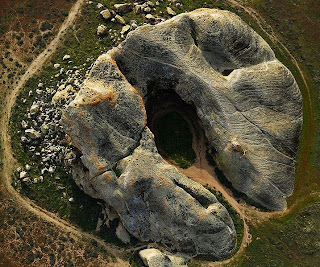For the ancient Chumash tribe of Southern California (refer to part 1 and part 2), the progressive movement south of the sun was a bad omen. It meant shorter days and colder weather. It meant that the whole community had to band together under the leadership of the Alchuklash, their powerful, omniscient astronomer/priests, to encourage the sun to turn around before there were no more days, only night.
They believed that all things are interconnected and that any action in the heavens affected the earth and humans and actions by humans affected the forces around them. I am reminded of the “butterfly effect” from chaos theory that stated that if a butterfly flaps his wings in South America, it can affect the weather in Texas -- the idea that small things can influence seemingly unrelated things because of the close connection of all things. The Chumash and many other cultures then and now believe that if you understand these interactions you can manipulate them to your benefit or, conversely, unwittingly bring about great catastrophes by not heeding or understanding the effects of your actions.
In the fall, the month the Chumash called “Hutash”, the Alchuklash began their preparations for the winter solstice. They tracked the sun’s progress and kept count of the days so they knew how many days after the autumn equinox they had until the winter solstice. They would come before the people and announce their prediction and order the preparation of the necessary ritual items needed. Year after year, their rituals had worked and influenced the sun to come back to them and they dared not alter their actions or, perhaps, the sun wouldn’t turn around. It was certainly too important to leave to chance.
 |
| Queen Butterfly of South America |
In the fall, the month the Chumash called “Hutash”, the Alchuklash began their preparations for the winter solstice. They tracked the sun’s progress and kept count of the days so they knew how many days after the autumn equinox they had until the winter solstice. They would come before the people and announce their prediction and order the preparation of the necessary ritual items needed. Year after year, their rituals had worked and influenced the sun to come back to them and they dared not alter their actions or, perhaps, the sun wouldn’t turn around. It was certainly too important to leave to chance.
“Hutash” is a complex word with many meanings but all relate to the “place where you are”. Hutash is the name of “Mother Earth” who planted the seeds that man sprouted from. It refers to the “axis of the earth” or the sphere where man resides. Hutash is the name of the evening star which ushers in the month of Hutash. It was also refered to as the mirror of the sun and the sun as the mirror of Hutash.
“Hutash” is a complex word with many meanings but all relate to the “place where you are”. Hutash is the name of “Mother Earth” who planted the seeds that man sprouted from. It refers to the “axis of the earth” or the sphere where man resides. Hutash is the name of the evening star which ushers in the month of Hutash. It was also refered to as the mirror of the sun and the sun as the mirror of Hutash.
As part of the preparations for the winter solstice in the month of Hutash, the Alchuklash and his 12 helpers brought out a small 18” stick with a round, painted rock affixed to one end. These “sunsticks” represented the axis of the earth, Hutash, and were an important part of the solstice ceremony. The rock was tilted at an angle so the the sun would shine directly on the top of the rock.
Here, quoting from "Living the Sky" is an account of the Hutash ceremony, "... the group [Alchuklash and 12 assistants] assembled in mid-morning. To start the ceremony the old men (antap) brought out several mysterious articles, among which was a whale vertabrae painted with an image of the sun. Each ray of the sun painting represented one of the twelve months of the year. After the persons attending placed offerings in several baskets that had been put there for the purpose, one of the old men, who had been sitting on the west side of the room facing east, began to sing three songs of gratitude to the sun as they all waited for the sun to rise symbolically. A young boy then took the painted sun, which had been lying horizontally on the floor, raised it up with a stick, and held it vertically for all to see. the sun had risen. Each woman with a babe still suckling brought him in and held him up to the sun paintings. Then the leader warned them all to respect Sun and lectured them to follow the proper path and to avoid the dangers to life and property that exist at this time of year. 'None of us in the assembly control our destiny, for we live in the shadow of the sun.'"
Following this ceremony, the Alchuklash priest took on his role as Sun Priest and his assistants became the rays of the sun. They prepared the people for the coming winter solstice and prepared for the ceremony that would entice the sun to stop moving south and start its movement northward again.
Link to Part 1
-- Courtney Miller














